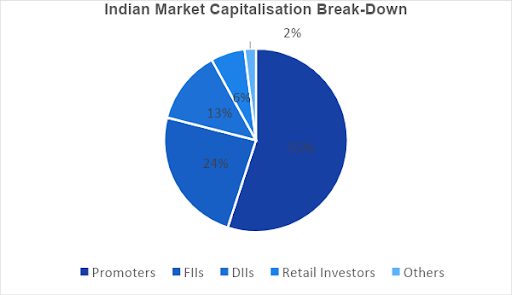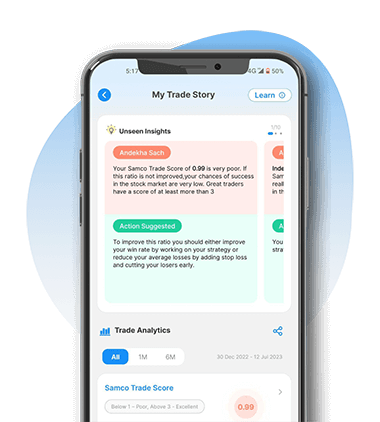Types of Investors
The minute we think of an investor…all we think about is a fellow retail investor. However, retail investors only own 6% stake in the Indian stock markets. Many people stay out of the investing game, because they find it intimidating. But finding out the types of investors that contribute in the market could get you much ahead in the game. In this article we will learn:- Type of investors grouped by investment category
- Type of investors grouped on basis of their investment styles
- Types of investors based on their risk appetite
1. Investors grouped by investment category
 The doughnut shows Indian stock market stake holding. The beauty of the Indian stock market is the diverse types of investors in the market. Let’s dive deeper into different types of investors, and find out which segment you belong to.
Retail investors are individuals investing in the capital markets. Their goal is to invest their savings to get better returns. Securities Exchange Board of India (SEBI) defines retail investors as individuals whose application size in initial public offerings (IPO) is less than Rs 2 lakhs.
Retail investors only own 6% stake in the Indian markets. These types of investors are generally vulnerable as they are uninformed. Retail investment pie is growing after demonetisation as household savings were diverted to financial markets. Covid 19 related lockdown led to an increase in participation of retail investors in the Indian stock markets.
The number of demat accounts opened in the last few years have sharply increased. If you still don’t have a demat account yet then simply click here to open it in 15 minutes.
The doughnut shows Indian stock market stake holding. The beauty of the Indian stock market is the diverse types of investors in the market. Let’s dive deeper into different types of investors, and find out which segment you belong to.
Retail investors are individuals investing in the capital markets. Their goal is to invest their savings to get better returns. Securities Exchange Board of India (SEBI) defines retail investors as individuals whose application size in initial public offerings (IPO) is less than Rs 2 lakhs.
Retail investors only own 6% stake in the Indian markets. These types of investors are generally vulnerable as they are uninformed. Retail investment pie is growing after demonetisation as household savings were diverted to financial markets. Covid 19 related lockdown led to an increase in participation of retail investors in the Indian stock markets.
The number of demat accounts opened in the last few years have sharply increased. If you still don’t have a demat account yet then simply click here to open it in 15 minutes.
High Networth Individuals (HNIs)
Investors’ with over two crores of investible assets are generally considered as HNIs. Net worth is the amount by which your assets exceed liabilities. Individuals with investible assets of more than Rs.25 lakhs to Rs.2 crores are considered as emerging HNIs’. For the IPO application HNIs need to apply through a separate category. The number of HNIs in India is predicted to touch 950,000 by 2027 according to wealth report. Currently the HNI’s in India have crossed 330,000 as per 2020.Domestic institutional investors (DII)
These institutional investors generally make investments in country they are based in. There are four main types of DIIs in the Indian stock markets. DIIs can either be: 1. Indian asset management companies (AMC) These are Indian mutual funds that pool huge sum of money from individual investors and make investments. These investments are headed by fund managers. Mutual funds buying and selling creates impact on the stock prices and overall markets. Example: HDFC AMC, ICICI Prudential AMC, Nippon Asset Management and UTI AMC, Aditya Birla Sun Life AMC. 2. Indian insurance companies Insurances companies like LIC, New India Assurance, Star Health, HDFC Life, ICICI Pru life, SBI Life too make some percentage of investments in stock markets. 3. Pension funds Pension funds are funds that provide financial support, that is much needed during retirement years. HDFC, SBI, Kotak have some well-known pension funds in India. 4. Banks Scheduled commercial banks also invest a small portion of the deposits they receive in the stock market. DIIs own a substantial stake in listed companies in India. They are an important component in the Indian stock markets.Foreign Institutional investors (FIIs) or Foreign Portfolio Investors (FPI)
These institutions are established outside India and make investments in India. FIIs are registered foreign institutions like:- Pension funds and mutual funds
- Sovereign wealth funds
- Hedge funds
2. Type of investors grouped on basis of their investment styles
Investment styles can broadly be divided into:- Value investors are investors who seek to find undervalued stocks. Their aim is to find fundamentally good stocks that trade at low price to earnings ratio (P/E). These investors look forward to appreciation in the value of their investments. Value investors usually are long-term investors.
- Growth Investors are inclined towards growth stocks. They invest in companies that are typically young and at an early growth stage. Return rate of such stocks are expected to rise above average market rate. A growth investor seeks accelerated growth in short period of time. Such investors are less concerned with current pricing. They lay more emphasis on the underlying business of the stock.
- Special Situation Investors are individuals who invest in companies where corporate actions like mergers, acquisition and takeovers are happening. These types of investors are inclined towards recent news. They tend to track stock markets closely when they are invested.
Watch our episode on Special Situation Investing with Jimeet Modi
- Traders are individuals who speculate on the stock prices of the company. They are looking to make quick returns by buying and selling stocks frequently. Their holding periods are generally shorter than investors. They could exit their positions in a few hours to a couple of days or weeks.
3. Types of investors with different risk appetite
Well, investors often think about how much returns their investment will generate. But the real question is – How much are you okay with losing on an investment? This is what they call risk appetite. Risk appetite refers to amount of loss an investor can handle while investing. An investor can afford to take risk on the basis of:- age factor,
- family dependency,
- financial plan and goals,
- investor’s comfort level etc.
- Awareness of financial products






Leave A Comment?